The body tape market is expected to grow from USD 2.5 billion in 2025 to USD 4.8 billion in 2035 at a CAGR of 6.9%. Growth is supported by fashion styling needs, skin-safe adhesive innovation, and broad online distribution. Adoption increases across bridalwear, event dressing, and everyday outfits that seek discreet support. Brands focus on hypoallergenic, breathable, and water-resistant variants that improve comfort and wear time. Education through creators and retailers boosts correct application, lowers returns, and encourages repeat purchase.
From 2025 to 2029, demand builds steadily as consumers shift to minimalist silhouettes and strapless designs. Trials increase through fashion e-commerce, specialty lingerie stores, and beauty retailers. Product ranges expand to include tone diversity, pre-cut strips, and starter kits. Clear usage guidance, safe removal tips, and dermatology claims improve confidence. Replacement cycles shorten as users learn proper placement and storage, which lifts repeat sales in key urban markets.
Between 2030 and 2035, scaling is driven by material upgrades and broader use cases. Sweat-resistant and waterproof options gain share in warm and humid regions. Multi-pack formats and travel rolls improve value perception. Cross-selling with shapewear, lingerie, and occasionwear raises attachment rates online and in modern trade. Brand investments in sensitive-skin adhesives and breathable backings extend wear time for long events, which supports premium pricing and margins.
Segment leadership remains consistent through the period. By type, double-sided body tape leads with a 41.8% share in 2025, supported by secure fabric-to-skin hold for strapless and backless outfits. By material, silicone leads with 36.2% in 2025, valued for gentle adhesion and low irritation risk. By application, fashion and apparel contributes 47.7% in 2025, as designers and stylists use tape to refine fit without visible hardware. Individual end use dominates, with commercial demand from stylists and costume teams.
Regionally, North America, Europe, and Asia-Pacific are the key growth theaters. Online channels expand reach through tutorials, reviews, and bundles, while offline sales benefit from assisted fittings in lingerie and department stores. Price tiers remain Low, Medium, and High, with premium tiers tied to hypoallergenic claims, longer wear time, and water resistance. As brands standardize sizing guides and shade ranges, consumer satisfaction improves, supporting stable, long-term growth through 2035.
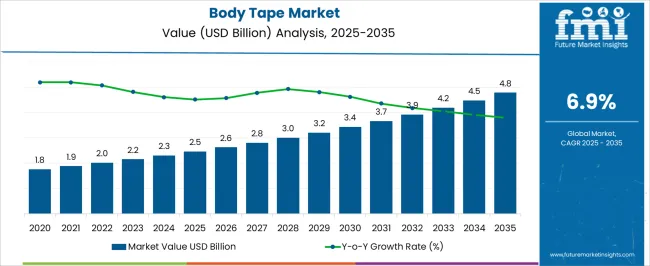
| Metric | Value |
|---|---|
| Body Tape Market Estimated Value in (2025 E) | USD 2.5 billion |
| Body Tape Market Forecast Value in (2035 F) | USD 4.8 billion |
| Forecast CAGR (2025 to 2035) | 6.9% |
The body tape market is experiencing steady growth, driven by rising demand in fashion and apparel for reliable, skin-friendly adhesive solutions. Industry insights point to increasing consumer preferences for products that offer comfort and durability, especially for use in intimate wear and special occasion outfits.
The popularity of body tapes that provide discreet support and shaping without visible straps has fueled innovation in material science, emphasizing skin safety and hypoallergenic properties. Additionally, evolving fashion trends that favor minimalistic and seamless designs have led to greater adoption of body tape across various garment types.
Online retail and specialty stores have expanded the availability of body tape, increasing consumer access. Market growth is expected to continue as new applications in costume design, sportswear, and medical uses emerge. Segmental leadership is expected from double-sided body tape in type, silicone in material, and fashion and apparel in application.
The body tape market is segmented by type, double-sided body tape, single-sided body tape, and medical-grade body tape; by material, silicone, cotton, acrylic, synthetic, and others; by application, fashion and apparel, medical and healthcare, cosmetics and beauty, and others; by end use, individual and commercial; by price, low, medium, and high; by distribution channel, online and offline; by region, North America, Europe, Asia-Pacific, Latin America, and Middle East & Africa.
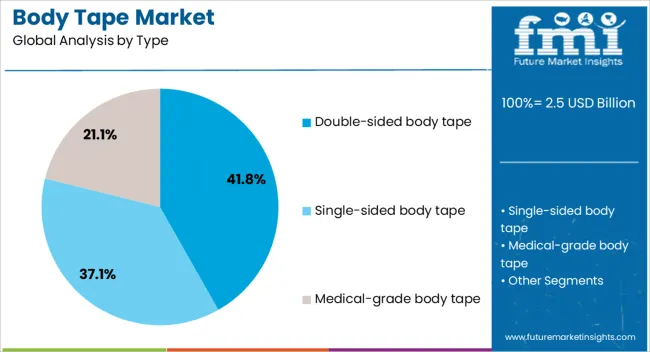
The double-sided body tape segment is projected to hold 41.8% of the market revenue in 2025, driven by its versatility and convenience. This tape type is favored for its ability to adhere securely to both skin and fabric, offering reliable support and garment fixation.
Its dual-adhesive design ensures minimal movement and long-lasting hold during active use or extended wear. The segment has gained popularity as it simplifies dressing challenges for strapless and backless apparel.
Increased consumer awareness of application techniques and improved adhesive formulas have enhanced user confidence and repeat purchases. The growing demand for discreet body shaping solutions further supports the segment's strong position.
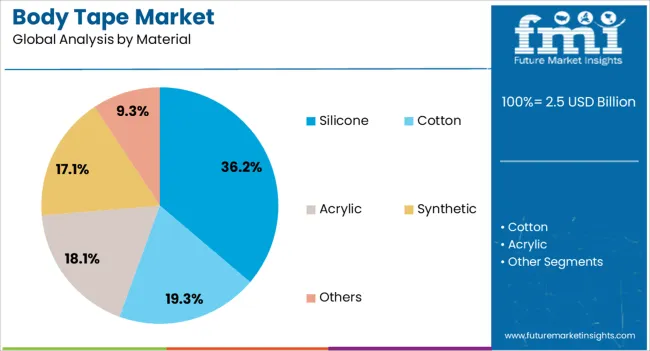
The silicone segment is expected to account for 36.2% of the body tape market revenue in 2025, leading material adoption due to its skin-friendly and hypoallergenic properties. Silicone adhesives provide gentle yet effective adhesion, reducing the risk of irritation and allergic reactions common with other adhesive types.
Their flexibility and breathability make them ideal for sensitive skin, enhancing wearer comfort. The segment has benefited from technological advances in silicone formulations that improve durability and water resistance.
These qualities have made silicone body tapes especially popular among consumers seeking safe, long-wear solutions for everyday and special occasion use.
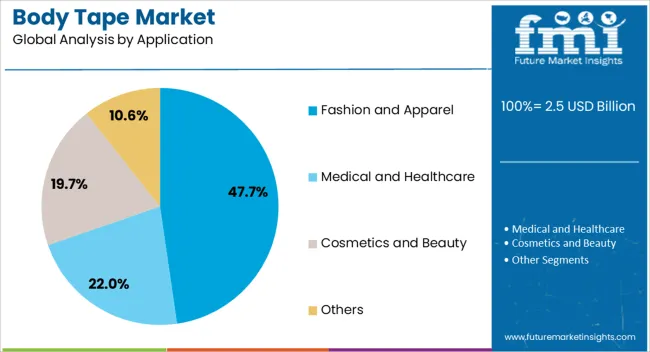
The fashion and apparel segment is projected to generate 47.7% of the body tape market revenue in 2025, maintaining its position as the largest application area. Growth in this segment is driven by evolving clothing styles that demand versatile and discreet support products.
Designers and consumers alike have embraced body tape for its ability to enhance fit and comfort without compromising aesthetics. The rise in occasions requiring formal or unconventional attire has increased reliance on body tape to address fit challenges.
Additionally, expanding fashion e-commerce platforms have improved product accessibility and consumer education on body tape usage. With ongoing fashion innovation, the segment is expected to continue driving market expansion.
Body tape demand is rising through fashion styling, material innovation, digital retailing, and wider lifestyle adoption. Its discreet finish, flexibility, and multipurpose use ensure its continued presence in personal care and fashion markets.
The body tape industry has gained momentum as it becomes an essential accessory in fashion styling, particularly for dresses, bridalwear, and event outfits that require discreet support. Consumers prefer body tape for its invisible finish, flexibility, and ease of application, replacing the need for bulky undergarments. Designers and stylists are increasingly recommending body tape for red carpet events, photoshoots, and high-fashion settings. The surge in demand has been amplified by influencer marketing and celebrity endorsements that highlight versatility across multiple outfit types. As fashion trends evolve toward minimalistic silhouettes, the role of body tape as a styling essential is expected to remain central.
Competition in the body tape market is influenced by innovation in adhesives, materials, and user comfort. Manufacturers are introducing hypoallergenic adhesives, breathable fabrics, and skin-tone variations to meet diverse customer needs. These developments have broadened adoption among sensitive-skin users while providing reliable hold for extended wear. Product ranges now include waterproof tapes, extra-strong adhesive options, and multi-use kits designed for sports or high-movement activities. Such diversification has enhanced the appeal of body tape as a premium beauty accessory. The push toward greater comfort and inclusivity has reinforced its reputation as a practical alternative to traditional support garments.
E-commerce has emerged as a powerful growth driver for body tape, enabling brands to reach a wide range of consumers globally. Online platforms provide visibility through influencer collaborations, user reviews, and demonstration content that educates customers about proper application. Cross-border e-commerce has further expanded brand access to new markets, especially in Asia-Pacific and North America. Subscription models and bundled kits are being tested to enhance consumer loyalty and repeat purchase behavior. As buyers increasingly rely on online channels for beauty and fashion accessories, body tape brands are strategically investing in digital campaigns and social media partnerships to maximize exposure.
While body tape remains popular for formalwear and special events, its usage is expanding into sports, dance, and everyday apparel. Athletes and performers use body tape to secure outfits during high-movement activities, while fitness enthusiasts find it useful for comfortable, flexible support. This diversification has opened opportunities in new retail categories such as sportswear and active lifestyle products. Manufacturers are highlighting body tape as a multipurpose product that combines aesthetic appeal with functional support. By tapping into active lifestyles and entertainment industries, the body tape market is extending its influence beyond traditional fashion, making it a versatile solution.

The body tape market is projected to grow globally at a CAGR of 6.9% between 2025 and 2035, supported by rising fashion trends, wider adoption in bridalwear, and growing e-commerce penetration across beauty and personal care accessories. China leads with a CAGR of 9.3%, fueled by rapid adoption among younger consumers, social media-driven styling, and expansion of domestic online retail platforms. India follows at 8.6%, driven by wedding-related demand, growth of organized retail, and increasing awareness of styling aids in urban centers. France records 7.2%, benefiting from strong luxury fashion, haute couture influence, and growing demand in premium retail outlets. The United Kingdom posts 6.6%, supported by event-based usage, rising adoption in the rental clothing market, and marketing by fashion influencers. The United States stands at 5.9%, shaped by Hollywood styling trends, adoption in sports and performance costumes, and steady sales through omnichannel distribution networks. The analysis spans over 40 countries, with these five serving as benchmarks for branding strategies, distribution expansion, and product innovation priorities in the global body tape industry.
China is projected to post a CAGR of 9.3% during 2025–2035, above the global benchmark of 6.9%, as fashion-forward urban consumers embrace styling aids across bridalwear, party dresses, and influencer-led looks. During 2020–2024, uptake was driven by e-commerce flash sales, KOL tutorials, and competitive pricing that educated first-time users. The stronger pace ahead is expected from deeper penetration in tier-two cities, wider shade ranges, and improved hypoallergenic adhesives that increase repeat purchase. Retailers are bundling tapes with shapewear and occasionwear, which raises basket value and encourages trials. Supply chains are improving with local converting lines, which shortens lead times and stabilizes margins in high-volume shopping festivals.
India is expected to achieve a CAGR of 8.6% for 2025–2035, above the global 6.9% rate, as wedding seasons, celebrity styling, and social media trends lift adoption across metros and rising urban clusters. Between 2020–2024, early growth came from premium boutiques and online marketplaces serving bridal and eventwear needs. The faster trajectory ahead is supported by organized retail expansion, rising carded assortments at chemists, and product education around comfort and skin safety. Multi-pack kits and travel-friendly rolls are being preferred by stylists and content creators, which improves visibility beyond special-occasion use. Cross-selling with lingerie and eveningwear is expected to raise attachment rates in modern trade and online channels.
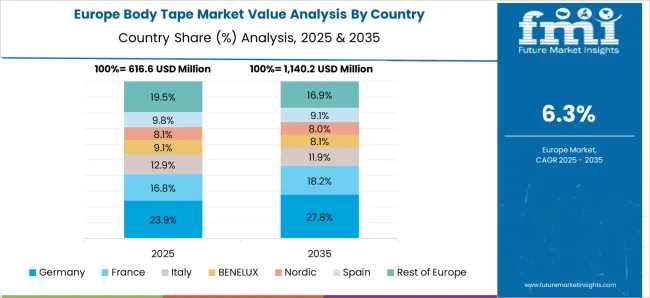
France is projected to grow at a CAGR of 7.2% during 2025–2035, modestly above the world rate, as couture houses and premium retailers promote discreet support solutions for minimal silhouettes. Earlier, in 2020–2024, momentum was built through department store counters, beauty specialty chains, and stylist recommendations for photoshoots and galas. The next phase should benefit from improved fabric bases, breathable backings, and tone diversity that meets professional standards for comfort during long events. Tourism-linked luxury purchases add incremental volume during fashion weeks and summer seasons. Packaging that emphasizes dermatology testing and clear removal guidance is increasing shopper confidence and reducing returns in omnichannel settings.
The United Kingdom is forecast to post a CAGR of 6.6% during 2025–2035, close to the global 6.9% baseline. During 2020–2024, the UK body tape market expanded at about 4.8%, a period shaped by careful spending, limited event calendars, and high import costs that tempered range depth. The uplift to 6.6% is linked to richer assortments in high-street fashion, rental clothing usage that favors temporary support, and better availability of hypoallergenic and sweat-resistant variants. Search interest for backless and plunge outfits has recovered, which increases attachment rates online. Retailers are pairing tapes with occasionwear edits, while improved distributor inventories shorten replenishment cycles and protect sell-through.
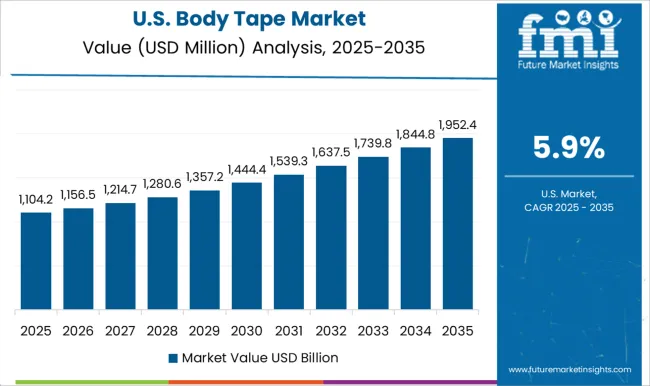
The United States is expected to record a CAGR of 5.9% for 2025–2035, steady but below the global average, as usage concentrates in red-carpet styling, dancewear, and performance costumes. Earlier, in 2020–2024, growth was anchored in online specialty beauty, festival seasons, and bridal boutiques. Future gains are anticipated from improved education on application for higher cup sizes, sweat-resistant options for warm climates, and bundling with shapewear kits in big-box retail. Hollywood-led visibility continues to influence peak seasons, while college events and prom segments add entry-level demand. Customer service that emphasizes fit tips and safe removal is improving reviews and reduces return rates across marketplaces.
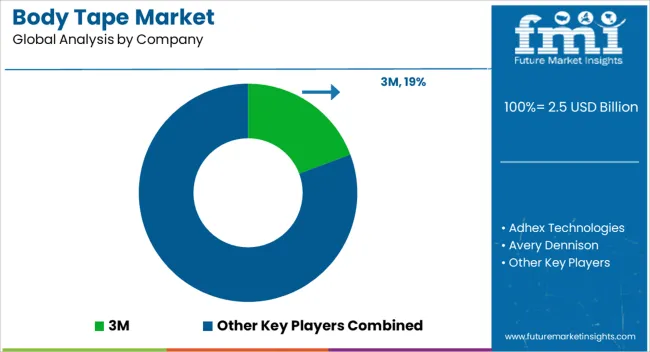
The body tape market consists of a dynamic mix of multinational adhesive manufacturers, fashion accessory brands, and specialized niche companies competing on comfort, skin safety, and product versatility. 3M leverages its global adhesive expertise to deliver hypoallergenic, medical-grade solutions adapted for beauty and apparel applications. Adhex Technologies focuses on customized adhesive coatings that enhance breathability and long wear. Avery Dennison provides skin-friendly adhesive technologies with a focus on durability and discreet application. Berry Global emphasizes large-scale production capacity and eco-conscious materials in its body tape portfolio.
Booby Tape has built strong consumer recognition through celebrity endorsements and social media-driven marketing. Braza offers a wide range of intimate apparel accessories, including body tapes for event and bridal wear. DermaMed Coatings specializes in medical-grade adhesives designed to minimize irritation, improving comfort for sensitive skin users. Easylife markets affordable, easy-to-use adhesive solutions tailored for mass-market accessibility. Fashion Forms continues to lead in lingerie accessories, offering diverse tapes and adhesives for fashion styling. Fearless Tape targets convenience-driven consumers with pre-cut, ready-to-use strips for fast application. Hollywood Fashion Secrets capitalizes on strong retail presence, branding itself as a go-to choice for discreet styling aids. Kinesio integrates expertise from therapeutic taping to create body solutions with additional skin support benefits.
| Item | Value |
|---|---|
| Quantitative Units | USD Billion |
| Type | Double-sided body tape, Single-sided body tape, and Medical-grade body tape |
| Material | Silicone, Cotton, Acrylic, Synthetic, and Others |
| Application | Fashion and Apparel, Medical and Healthcare, Cosmetics and Beauty, and Others |
| End Use | Individual and Commercial |
| Price | Medium, Low, and High |
| Distribution Channel | Online and Offline |
| Regions Covered | North America, Europe, Asia-Pacific, Latin America, Middle East & Africa |
| Country Covered | United States, Canada, Germany, France, United Kingdom, China, Japan, India, Brazil, South Africa |
| Key Companies Profiled | 3M Company, Adhex Technologies, Avery Dennison Corporation, Berry Global Inc., Booby Tape Pty Ltd, The Braza Group Inc., DermaMed Coatings Company LLC, Fashion Forms LLC, Hollywood Fashion Secrets, Nitto Denko Corporation, Scapa Group Ltd. |
| Additional Attributes | Dollar sales, share, consumer usage patterns, regional demand growth, retail vs. e-commerce trends, competitor pricing, product innovation, regulatory compliance, influencer impact, and forecasted CAGR to guide strategy. |
The global body tape market is estimated to be valued at USD 2.5 billion in 2025.
The market size for the body tape market is projected to reach USD 4.8 billion by 2035.
The body tape market is expected to grow at a 6.9% CAGR between 2025 and 2035.
The key product types in body tape market are double-sided body tape, single-sided body tape and medical-grade body tape.
In terms of material, silicone segment to command 36.2% share in the body tape market in 2025.






Our Research Products

The "Full Research Suite" delivers actionable market intel, deep dives on markets or technologies, so clients act faster, cut risk, and unlock growth.

The Leaderboard benchmarks and ranks top vendors, classifying them as Established Leaders, Leading Challengers, or Disruptors & Challengers.

Locates where complements amplify value and substitutes erode it, forecasting net impact by horizon

We deliver granular, decision-grade intel: market sizing, 5-year forecasts, pricing, adoption, usage, revenue, and operational KPIs—plus competitor tracking, regulation, and value chains—across 60 countries broadly.

Spot the shifts before they hit your P&L. We track inflection points, adoption curves, pricing moves, and ecosystem plays to show where demand is heading, why it is changing, and what to do next across high-growth markets and disruptive tech

Real-time reads of user behavior. We track shifting priorities, perceptions of today’s and next-gen services, and provider experience, then pace how fast tech moves from trial to adoption, blending buyer, consumer, and channel inputs with social signals (#WhySwitch, #UX).

Partner with our analyst team to build a custom report designed around your business priorities. From analysing market trends to assessing competitors or crafting bespoke datasets, we tailor insights to your needs.
Supplier Intelligence
Discovery & Profiling
Capacity & Footprint
Performance & Risk
Compliance & Governance
Commercial Readiness
Who Supplies Whom
Scorecards & Shortlists
Playbooks & Docs
Category Intelligence
Definition & Scope
Demand & Use Cases
Cost Drivers
Market Structure
Supply Chain Map
Trade & Policy
Operating Norms
Deliverables
Buyer Intelligence
Account Basics
Spend & Scope
Procurement Model
Vendor Requirements
Terms & Policies
Entry Strategy
Pain Points & Triggers
Outputs
Pricing Analysis
Benchmarks
Trends
Should-Cost
Indexation
Landed Cost
Commercial Terms
Deliverables
Brand Analysis
Positioning & Value Prop
Share & Presence
Customer Evidence
Go-to-Market
Digital & Reputation
Compliance & Trust
KPIs & Gaps
Outputs
Full Research Suite comprises of:
Market outlook & trends analysis
Interviews & case studies
Strategic recommendations
Vendor profiles & capabilities analysis
5-year forecasts
8 regions and 60+ country-level data splits
Market segment data splits
12 months of continuous data updates
DELIVERED AS:
PDF EXCEL ONLINE
Tape Unwinder Market Size and Share Forecast Outlook 2025 to 2035
Tape Dispenser Market Size and Share Forecast Outlook 2025 to 2035
Body Armor Plates Market Size and Share Forecast Outlook 2025 to 2035
Body Composition Monitor and Scale Market Size and Share Forecast Outlook 2025 to 2035
Tape Dispenser Industry Analysis in Japan Size and Share Forecast Outlook 2025 to 2035
Tape Dispenser Industry Analysis in Western Europe Size and Share Forecast Outlook 2025 to 2035
Body Blurring Cosmetics Market Size and Share Forecast Outlook 2025 to 2035
Body Contouring Market Size and Share Forecast Outlook 2025 to 2035
Tape Measure Market Size and Share Forecast Outlook 2025 to 2035
Body Fat Reduction Market Growth - Trends & Forecast 2025 to 2035
Tape Backing Materials Market Analysis by Material Type, Application, and Region through 2025 to 2035
Body Armor Market Analysis - Size, Share & Forecast 2025 to 2035
Tape Stretching Line Market Analysis – Growth & Trends 2025 to 2035
Tapes Market Insights – Growth & Demand 2025 to 2035
Tape Banding Machine Market Overview - Demand & Growth Forecast 2025 to 2035
Body-Worn Temperature Sensors Market Analysis by Type, Application, and Region through 2025 to 2035
Body Fat Measurement Market Analysis - Trends, Growth & Forecast 2025 to 2035
Body Slimming Devices Market Analysis by Product, End-User and Region through 2035
Competitive Overview of Tape Dispenser Companies
Competitive Overview of Tape Backing Materials Companies

Thank you!
You will receive an email from our Business Development Manager. Please be sure to check your SPAM/JUNK folder too.
Chat With
MaRIA